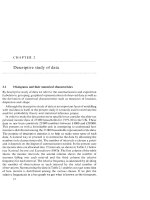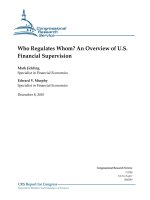TÀI CHÍNH TIỀN TỆ Lecture 1 chapter 2 an overview of financial system
Bạn đang xem bản rút gọn của tài liệu. Xem và tải ngay bản đầy đủ của tài liệu tại đây (669.63 KB, 22 trang )
UNIVERSITY OF FINANCE-MARKETING
The Economics of MBFM
Lecture-1
Chapter 2: An overview of financial system
Lecturer: Sumit, Ph.D.(in progress), MPA, MFC, NCFM, PGDPM
Today’s Lecture
•
•
•
•
•
•
•
•
•
Overview
Functions of financial markets
Flow of fund through financial system
Structure of financial markets
Financial market instruments
Internationalization of financial markets
function of financial intermediaries
Types of financial intermediaries
Regulations of financial system
Overview
•
Financial market(bond and stock) and financial intermediaries have the basic
function of getting people together to transfer fund one to another.
•
Well-functions financial markets and financial intermediaries are crucial to
economic health.
•
We need to acquire an understanding of their structure and operations
Function of Financial Markets
•
Perform the essential function of channeling funds from economic players that have
saved surplus funds to those that have a shortage of funds
•
Direct finance: borrowers borrow funds directly from lenders in financial markets by
selling them securities(financial instruments).
–
•
Example: borrow the funds from savers by selling them a bond, a debt security, that promises to
make payments periodically for a specified period of time. OR stocks, a security that entitles the
owner to a share of the company’s profit and losses
Why is this channeling of fund from savers to spenders so important to the
economy?
–
People who save are frequently not the same people who have profitable investment
opportunities.
Function of Financial Markets (cont’d)
•
Without financial market, , its hard to transfer fund from a
person who who has not investment opportunities to one who
has them.
– Thus
FM promotes economic efficiency by producing an efficient
allocation of capital, which increases production
•
Directly improve the well-being of consumers by allowing them
to time purchases better
Figure 1 Flows of Funds Through the Financial System
Lender to saver as loan
Borrow by Selling securities
Structure of Financial Markets
Contractual agreement by the borrower to pay
the holder of the instrument fixed dollar
•
amount at regular intervals until a specified
Debt and Equity Markets
date, when final payment made
– Debt instruments (maturity)
– Equities (dividends)
•
Own portion of firm and right to vote to elect its directors
Primary and Secondary Markets
– Investment Banks underwrite securities in primary markets
– Brokers and dealers work in secondary markets
Structure of Financial Markets (cont’d)
•
•
Secondary market can be organized in 2 ways.
–
Exchanges: NYSE, Chicago Board of Trade
–
OTC Markets: Foreign exchange, Federal funds
Another way to distinguishing between markets is on the basis of the maturity of securities traded in each
market
–
Money and Capital Markets
•
Money markets deal in short-term debt instruments. Corporations and banks actively use the
money market to each interest on surplus funds.
•
Capital
markets
deal
in
longer-term
debt
and
equity instruments. Stocks and bonds are often held by financial intermediaries such as insurance
companies and pension fund.
Issues by large banks and corporation such as Microsoft and General motors
Financial Markets instruments
•
Securitas traded in financial markets called financial instruments :
– Money market instruments
• US treasury bills
• Negotiable bank certificates of deposit
• Commercial paper
• Repurchase agreements
• Federal funds
Lest price fluctuations so least risky
US securities Issued for 1,3,6 month maturities. Pay
set amount at maturity and have no interest. So
initially selling at discount
Sold by bank to depositors that pay annual interest of giving and
amount and at maturity pays back the original purchase price
Effectively short term loans (maturity less than 2 weeks) for which
TB serve as collateral ,an assets that the lender receives if the
borrower does not pay back the loan
One bank Borrowing from another bank
Issued by US treasury to finance the deficit the federal government
Financial Markets instruments
– Capital market instruments
• Stocks
• Mortgages and mortgage backed securities
• Corporate bonds
• US government securities
• US agency securities
• State and local government bonds
• Consumer and bank commercial loans
Too much price fluctuation so More risk securities
Issues by corporation with strong credit ratings. This bond sends
holder interest twice in a year and pays off the face value at
maturity
Issued by various Govt. agencies,
Issued by state or local government to finance expenditure on
schools, roads and other large programs
Table 1 Principal Money Market Instruments
Table 2 Principal Capital Market Instruments
Internationalization of Financial Markets
•
Foreign corporations and banks raise funds from US and foreigners have become important investors in the US. A look
at international bond market and world stock markets will give us a picture of how their globalization of financial
markets is taking place.
–
Foreign Bonds: sold in a foreign country and denominated in that country’s currency
–
Eurobond: bond denominated in a currency other than that of the country in which it is sold. Bond dominated in
USD sold in London.
–
Eurocurrencies: foreign currencies deposited in banks outside the home country
–
Eurodollars: U.S. dollars deposited in foreign banks outside the U.S. or in foreign branches of U.S. banks
–
World Stock Markets
•
Also help finance the federal government
Function of Financial Intermediaries: Indirect Finance
•
Fund can move from lenders to borrowers by a second route, called indirect finance because it involves a
financial intermediary that stands between the lender-savers and the borrower-spenders and helps transfer funds
form one to the other
–
Lower transaction costs (time and money spent in carrying out financial transactions)
•
•
–
Economies of scale(bank hire one lawyer to make loan at fixed payment)
Financial intermediaries can reduce that
Liquidity services(online service to pay bills)
Reduce the exposure of investors to risk
•
Risk Sharing at low transaction cost (Asset Transformation): create and sell assets at risk characteristics and from sales
money buy another another assets and so on, so risk sharing at low cost
•
Diversification: pooling a collection of assets into a new asset and then selling it to individuals
Function of Financial Intermediaries: Indirect Finance (cont’d)
•
•
Deal with asymmetric information problems (before the transaction)
Adverse Selection: try to avoid selecting the risky borrower.
•
•
•
Gather information about potential borrower.
Not lend to either customer
Moral Hazard(after transaction): ensure borrower will not engage in activities that will prevent
him/her to repay the loan.
•
•
Sign a contract with restrictive covenants.
Economic of scope: e.g. before loan to coy evaluate credit risk of coy then loan coz later it will be
easy for coy to sell bond to public
Types of Financial Intermediaries
•
They fall into 3 categories:
–
Depository institutions(banks)
•
•
•
–
Savings and loan associations and mutual saving banks(allow time and checks writing)
Credit unions
Contractual savings institutions(insurance coy and pension funds)
•
•
•
–
Commercials banks(fixed deposit and no checks writing)
Life insurance companies
Fire and casualty insurance companies(more liquid than life)
Pension funds and government retirement funds
Investment intermediaries(finance companies and MF).
•
•
•
Finance companies(selling CP)
Mutual funds(get fund by selling stocks and diversified portfolio of stocks )
Investment banks
Table 3 Primary Assets and Liabilities of Financial
Intermediaries
Table 4: Principal Financial Intermediaries and Value of Their Assets
Regulation of the Financial System
•
To increase the information available to investors:
– Reduce adverse selection and moral hazard problems
– Reduce insider trading (SEC).
Regulation of the Financial System (cont’d)
•
To ensure the soundness of financial intermediaries:
– Restrictions on entry (chartering process, hard rules).
– Disclosure of information(FS).
– Restrictions on Assets and Activities (control holding of risky assets).
– Deposit Insurance (avoid bank runs).
– Limits on Competition (mostly in the past):
•
•
Branching(not many branches)
Restrictions on Interest Rates
Table 5 Principal Regulatory Agencies of the U.S. Financial System
If you have any question, please
feel free to ask









